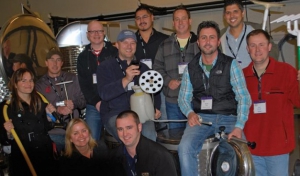Washington’s wine industry is equipping the next generation with leadership skills.

Young guns of Washington’s wine industry from left to right, top row: Michelle Moyer, Washington State University; Jason Helm, Ste. Michelle Wine Estates; Jim Harbertson, WSU; Jason Schlagel, Ste. Michelle; Victor Palencia, Jones of Washington and J & S Crushing; Derek Way, Sagemoor Vineyards; Dustin Tobin, Milbrandt Vineyards; Joe Cotta, Ste. Michelle; Jim Mills, Hogue Cellars. Bottom row: Catherine Jones, Yakima Valley Community College; and Bryan Weil, Hogue Cellars.
As chair of a statewide wine grape grower group, Lynne Chamberlain of Walla Walla Valley’s Spofford Station Vineyard is focused on issues that help vineyardists grow quality wine grapes. But she’s equally passionate about growing new grape leaders, a pet project she has helped nurture.
Chamberlain, the first female chair of the Washington Association of Wine Grape Growers, has been the driving force in the organization’s leadership development program, a relatively new effort to equip the wine grape industry’s “young guns” with the tools needed to become industry leaders.
She knows that getting involved in industry organizations can be daunting for the younger generation just out of college who lack years of industry experience, knowledge about issues, and personal relationships with industry leaders. So, as part of the group’s education and outreach, the Grape Association has created an ongoing leadership development program to build skills of the next generation.
Last year, during the annual meeting of the Grape Association, more than 80 young industry members participated in the group’s first professional development session. During the workshop, the younger generation was introduced to current industry issues and challenges, wine industry groups at the state, regional, and national levels, and learned about group decision-making and consensus building.
Since then, about 40 young industry members involved in both enology and viticulture have attended quarterly workshops featuring such topics as: giving an effective media interview, public speaking, building relationships with industry leaders, and how to “work” a room. At the most recent session held in mid-December, attendees learned about the political process, how to lobby industry interests, and the Washington State’s viticulture and enology education consortium (who teaches what among the colleges and universities). As a result of the political discussion, nearly ten young industry members planned to participate in a “Capitol Hill” day in Olympia in January.
At the end of the sessions, past presidents of the Grape Association attend a networking social hour to become acquainted with the young generation. “Young industry members are often afraid to introduce themselves to the industry giants,” Chamberlain said, adding that the past presidents have been committed to help mentor the younger generation.
“I have been fortunate to have mentors teach me that long-term success depends on my ability to read and adjust to market conditions,” said Chamberlain. “My long-term mission is to see that WAWGG is providing the tools needed to keep wine and grape careers growing.”
Next leaders
Chamberlain said when she first joined the board of directors, she noticed that many of the industry stalwarts—strong, industry statesmen—were retiring from the board.
“I started wondering who was going to pick up the slack? When I looked around at the membership ranks, I saw a lot of young people who had not yet gotten involved, not even in the association’s committee structure. It just hit me, ‘Who’s going to take my place?’”
At the same time, Chamberlain recalls reading an article by George Ambler about a global leadership forecast study that found leadership skills to be lacking in the young work force. “I thought, ‘If we didn’t start making the young generation welcome and get them involved, it would be a great travesty.’”
In talking to the young members, she found a disconnect between the generations and a young generation that still needed to build job-related confidence. Since the board’s decision to develop a formal leadership program more than a year ago, Chamberlain has worked to promote the program she has dubbed the “Young Guns” and has personally attended all of the workshops.
In addition the Young Guns program, the Grape Association is also cosponsoring a grape seat in Washington’s Agriculture and Forestry Leadership Program.
Stepping up
Dustin Tobin, 29, who joined the wine grape industry in 2005 after attending Washington State University and Walla Walla Community College, is proof that the leadership development program is paying dividends. Tobin, who’s been to every one of the leadership workshops, will moderate a leadership development session this year during the group’s annual convention. Last summer, he served as co-chair of the committee that organized the annual summer tour. The daylong event, with more than 100 participants, focused on the Yakima Valley appellation, with visits to vineyards and wineries.
Through his involvement with several wine industry internships and employment at Milbrandt Vineyards as viticulturist and grower relations, Tobin has watched industry leaders in action for the last six years. “I’ve seen great industry leaders and know that the bar is raised high. I want to make sure my generation meets and exceeds the needs of
the industry.”
Tobin is also a member of the newest class of the Ag Forestry leadership program.

Leave A Comment